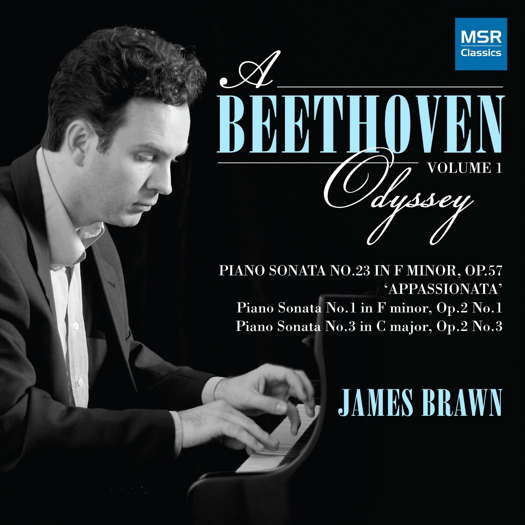
Masterfully Controlled
James Brawn's
Beethoven Odyssey -
impresses
ANDREW SCHARTMANN'... the movement bubbles over with excitement ...'
|

|
When Beethoven moved from Bonn to Vienna in 1792, he sought to make his mark not as a composer, but as a pianist. That is not to say he didn't expend a significant amount of energy composing — performance and composition were intimately joined in Beethoven's time — but his principal aim was to establish himself as a performer in the courts of the nobility.
Given the historical context in which the early sonatas were conceived, it is curious how many pianists treat them as divinely inspired objects to be approached in the loftiest of manners. In other words, despite the variety of faces that appear throughout the set of 32 sonatas, we are given the impression that the overall spiritual plane, so to speak, is of the highest order throughout.
James Brawn's refreshing interpretation dispels this notion. Rather than treating the Op 2 sonatas (Nos 1 and 3 are included in the recording) as religious relics, he injects each piece with a verve and panache in keeping with the true spirit of their conception. This is especially true of his interpretation of Op 2 No 1.
Brawn's is one of the few recordings that captures the first movement's meter (cut-time) correctly. While many performances lead us to believe that the movement is in 4/4, Brawn gives us a youthful burst of excitement in duple time. His execution of the opening theme is particularly effective: unlike so many pianists, he resists the urge to slow down into the fermata, instead maintaining a strict and pressing tempo. As such, the silence comes to life, suspending our very heartbeat as we wait to hear what path the music will take.
Listen -- Beethoven: Allegro (Piano Sonata in F minor, Op 2 No 1)
(track 1, 0:00-0:54) © 2013 James Brawn:
In contrast to the opening movement, the second is airy and simple in both character and form. With an astute musical sense, Brawn again resists the common tendency to interpret this music as though Beethoven were already a towering genius — the very definition of the romantic composer, replete with all of its attendant philosophical complexities. And instead we are introduced to a simple world of beautifully shaped phrases and masterfully controlled harmonic hues.
Listen -- Beethoven: Adagio (Piano Sonata in F minor, Op 2 No 1)
(track 2, 2:20-3:32) © 2013 James Brawn:
Brawn's exuberant approach extends to the finale, in which one can almost sense the piano buckling under the weight of Beethoven's schizophrenic Prestissimo. In comparison to the consistent energy-level of the movements mentioned thus far, however, the presentation of the third movement raises some eyebrows. Brawn's tempo is slow — lethargic, even. One might justify this restraint on the grounds that it allows the trio's invertible counterpoint to shine, but such sacrifice for contrapuntal clarity seems too large. Why risk the aesthetic brilliance of the whole for a short exercise in two-voice writing?
Listen -- Beethoven: Menuetto (Piano Sonata in F minor, Op 2 No 1)
(track 3, 0:00-0:36) © 2013 James Brawn:
This hiccup notwithstanding, Brawn's vivacious sound continues to impress upon the listener an accurate notion of the context in which these early sonatas were written. His interpretation of the scherzo from Beethoven's virtuosic Op 2 No 3 sonata is a case in point. In Brawn's hands, the movement bubbles over with excitement, constantly toeing the line between the upper limits of tempo and a complete technical breakdown. The result is exhilarating.
Listen -- Beethoven: Scherzo (Allegro) and Trio (Piano Sonata in C Op 2 No 3)
(track 7, 1:47-2:45) © 2013 James Brawn:
Two more laudable aspects of Brawn's playing shine through in the trio section of this passage and throughout the final sonata on the disc (Op 57, Appassionata): a warm, full-sounding bass voice and a formidable technique. It is true that performances by many pianists exhibit both of these features, but rarely does an artist bring the two together in such convincing balance. After all, warmth and bravura are difficult to reconcile; one usually causes the other to suffer. Not so with Brawn.
Listen -- Beethoven: Allegro ma non troppo — Presto (Piano Sonata in F minor, Op 57)
(track 11, 6:30-7:47) © 2013 James Brawn:
This warmth and roundness of sound is even more evident in the opening of the Appassionata's middle movement, in which we again witness Brawn adjusting his aesthetic approach to suit the context of the piece at hand. His performance of the main theme is absent of affectations, simple yet reflective — a meditation in tones. And so we transition from Beethoven the aspiring virtuoso to Beethoven the philosopher.
Listen -- Beethoven: Andante con moto (Piano Sonata in F minor, Op 57)
(track 10, 0:00-1:40) © 2013 James Brawn:
Brawn's journey through these towering works is one of the most convincing I've heard in a long time, yet it is difficult to articulate why. There is an element of purity in his playing — some ineffable quality — that transforms even the simplest of phrases into something pristine, something perfect. This quality is likely to remain ineffable, but the intrigue of the matter is fascinating in and of itself. Either way, Brawn has given us lots to think about as we await the second chapter of his odyssey.
Copyright © 14 October 2013
Andrew Schartmann,
Connecticut USA

| 
